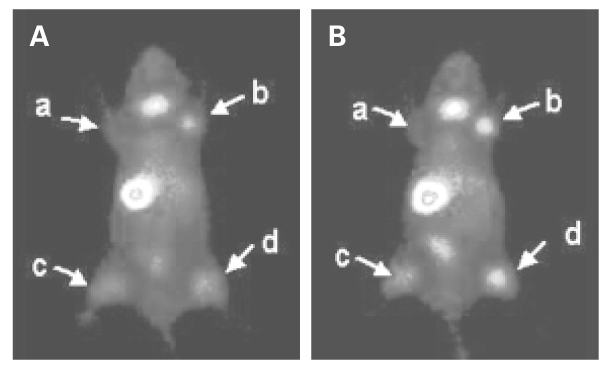J Korean Med Assoc.
2004 Feb;47(2):112-118. 10.5124/jkma.2004.47.2.112.
General Perspectives on Molecular Imaging
- Affiliations
-
- 1Department of Nuclear Medicine, Cancer Research Institute, Seoul National University College of Medicine and Hospital, Korea. jkchung@plaza.snu.ac.kr, kang2325@snu.ac.kr
- KMID: 1936464
- DOI: http://doi.org/10.5124/jkma.2004.47.2.112
Abstract
- Motecular imaging provides a visualization of normal as well as abnormal cellular processes at a molecular or genetic level rather than at the anatomical level. Molecular imaging is rapidly emerging and a multidisciplinary field coordinating medicine, molecular cell biology, chemistry, pharmacology, genetics, biomedical engineering, and physics. Conventional medical imaging methods utilize the imaging signals produced by nonspecific physico chemical interaction. However, molecular imaging methods utilize the imaging signals derived from specific cellular or molecular events. Because molecular and genetic changes precede anatomical change in the course of disease development, molecular imaging can detect early events in disease progression. Molecular imaging includes images of proteomics, metabolism, cellular biologic processes as well as genetics. In a narrow sense, molecular imaging means genetic imaging using imaging reporter genes. We can image diverse cellular processes including gene expression, proteinprotein interaction, signal transduction pathway, and monitoring of target cell distribution (cancer cells, immune cells, and stem cells) by imaging reporter gene. Molecular imaging methods are classified as optical imaging, nuclear imaging and magnetic resonance imaging. Each imaging modalities have their advantages and weaknesses. In the near future, through molecular imaging we can understand basic mechanisms of disease, and diagnose earlier and, subsequently, treat earlier intractable diseases such as cancer, neuro degenerative diseases, and immunologic disorders.
MeSH Terms
Figure
Reference
-
1. Hadjantonakis AK, Dickinson ME, Fraser SE, Papaioannou VE. Technicolour transgenics: imaging tools for functional genomics in the mouse. Nat Rev Genet. 2003. 8:613–625.
Article2. Lok C. Picture perfect. Nature. 2001. 412:372–374.
Article3. Gambhir SS, Barrio JR, Phelps ME, Iyer M, Namavari M, Herschman HR, et al. Imaging adenoviral-directed reporter gene expression in living animals with positron emission tomography. Proc Natl Acad Sci USA. 1999. 96:2333–2338.
Article4. Tjuvajev JG, Avril N, Oku T, Sasajima T, Miyagawa T, Blasberg RG, et al. Imaging herpes virus thymidine kinase gene transfer and expression by positron emission tomography. Cancer Res. 1998. 58:4333–4341.5. Tjuvajev JG, Joshi A, Callegari J, Lindsley L, Joshi R, Blasberg RG, et al. A general approach to the non-invasive imaging of transgenes using cis-linked herpes simplex virus thymidine kinase. Neo-plasia. 1999. 1:315–312.
Article6. Yu Y, Annala AJ, Barrio JR, Toyokuni T, Satyamurthy N, Gambhir SS, et al. Quantification of target gene expression by imaging reporter gene expression in living animals. Nat Med. 2000. 6:933–937.
Article7. Liang Q, Satyamurthy N, Barrio JR, Toyokuni T, Phelps MP, Herschman HR, et al. Noninvasive, quantitative imaging in living animals of a mutant dopamine D2 receptor reporter gene in which ligand binding is uncoupled from signal transduction. Gene Ther. 2001. 8:1490–1498.
Article8. Chung JK. Sodium iodide symporter: Its role in nuclear medicine. J Nucl Med. 2002. 43:1188–1120.9. Jacobs A, Voges J, Reszka R, Lercher M, Gossmann A, Heiss WD, et al. Positron-emission tomography of vector-mediated gene expression in gene therapy for gliomas. Lancet. 2001. 358:727–729.
Article10. Doubrovin M, Ponomarev V, Beresten T, Balatoni J, Bornmann W, Gelovani Tjuvajev, et al. Imaging transcriptional regulation of p53-dependent genes with positron emission tomography in vivo. Proc Natl Acad Sci USA. 2001. 98:9300–9305.
Article11. Kim KI, Chung JK. Evaluation of endogenous p53 expression level using NIS as an imaging reporter gene. SNM. 2003. 51:88.12. Ponomarev V, Doubrovin M, Lyddan C, Beresten T, Balatoni J, Tjuvajev JG, et al. Imaging TCR-dependent NFAT-mediated T-cell activation with positron emission tomography in vivo. Neoplasia. 2001. 3:480–488.
Article13. Miller MJ, Wei SH, Cahalan MD, Parker I. Autonomous T cell trafficking examined in vivo with intravital two-photon microscopy. Proc Natl Acad Sci USA. 2003. 100:2604–2609.
Article14. Miller MJ, Wei SH, Parker I, Cahalan MD. Two-Photon Imaging of Lymphocyte Motility and Antigen Response in Intact Lymph Node. Science. 2002. 296:1869–1873.
Article15. Dubey P, Su H, Adonai N, Du S, Rosato A, et al. Quantitative imaging of the T cell antitumor response by positron-emission tomography. Proc Natl Acad Sci USA. 2003. 100:1232–1237.
Article16. Sorger JM, McVeigh ER, Hill JM. MRI tracking of mesenchymal stem cell homing to myocardial infarction. SMI. 2003. 2:221.17. Paulmurugan R, Umezawa Y, Gambhir SS. Noninvasive imaging of protein-protein interactions in living subjects by using reporter protein complementation and reconstitution strategies. Proc Natl Acad Sci USA. 2002. 99:15608–15613.
Article18. Paulmurugan R, Massoud TF, Huang J, Gambhir SS. Modulation of a split synthetic Renilla luciferase complementation-based protein-protein interaction using the small molecule rapamycin in cells and in living animals. SMI. 2003. 2:198.
- Full Text Links
- Actions
-
Cited
- CITED
-
- Close
- Share
- Similar articles
-
- General Perspectives for Molecular Nuclear Imaging
- Deep Learning in Nuclear Medicine and Molecular Imaging: Current Perspectives and Future Directions
- Molecular Optical Imaging in Neuroscience
- The Growing Problem of Radiologist Shortages: Perspectives From Singapore
- Will Molecular Optical Imaging Have Clinically Important Roles in Stroke Management, and How?


